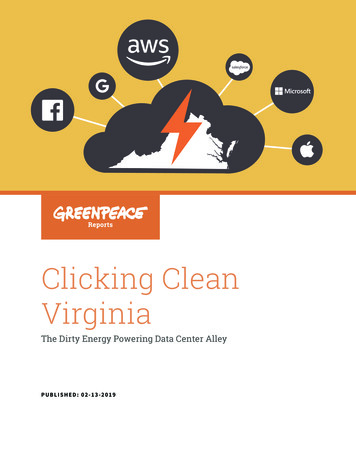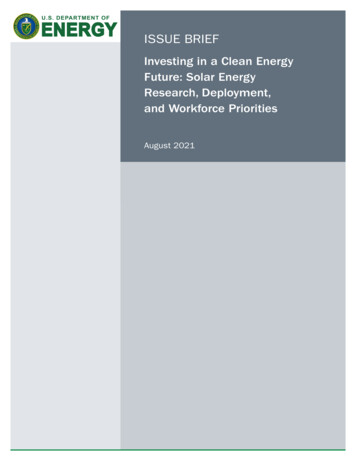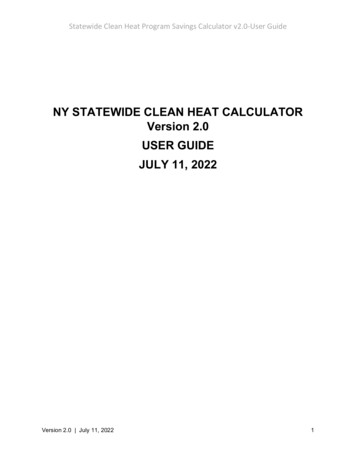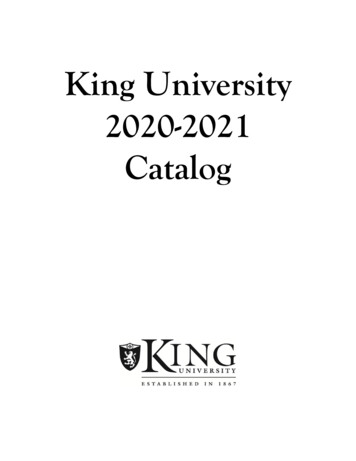
Transcription
Clicking CleanVirginiaThe Dirty Energy Powering Data Center AlleyPUBLISHED: 02-13-2019
Contents Executive Summary . . . . . . . . . . . . . . . . . . . . . . . . . . . . . . . . . . . . . . . . . . . . . . . . . . . . . . . . . . . . . . .3 Company Scorecard . . . . . . . . . . . . . . . . . . . . . . . . . . . . . . . . . . . . . . . . . . . . . . . . . . . . . . . . . . . . . . .6 Data Center Alley: Where the Cloud Touches the Ground. . . . . . . . . . . . . . . . . . . . . . . . . . . . . . .7 How Dirty is Your Data?. . . . . . . . . . . . . . . . . . . . . . . . . . . . . . . . . . . . . . . . . . . . . . . . . . . . . . . . . . . . .8 Building A Clean(er) Cloud. . . . . . . . . . . . . . . . . . . . . . . . . . . . . . . . . . . . . . . . . . . . . . . . . . . . . . . . .10 Dominion Energy: Making Your Data Dirty . . . . . . . . . . . . . . . . . . . . . . . . . . . . . . . . . . . . . . . . . . .12 New Climate Threat: The Atlantic Coast Pipeline . . . . . . . . . . . . . . . . . . . . . . . . . . . . . . . . . . . . .13 Amazon Web Services: Virginia’s Dirty Cloud. . . . . . . . . . . . . . . . . . . . . . . . . . . . . . . . . . . . . . . . .15 Charting a Renewable Path for Virginia. . . . . . . . . . . . . . . . . . . . . . . . . . . . . . . . . . . . . . . . . . . . . .17 Methodology. . . . . . . . . . . . . . . . . . . . . . . . . . . . . . . . . . . . . . . . . . . . . . . . . . . . . . . . . . . . . . . . . . . . .22 Company Profiles. . . . . . . . . . . . . . . . . . . . . . . . . . . . . . . . . . . . . . . . . . . . . . . . . . . . . . . . . . . . . . . . .24 Amazon Web Services. . . . . . . . . . . . . . . . . . . . . . . . . . . . . . . . . . . . . . . . . . . . . . . . . . . . . . . .24 Apple. . . . . . . . . . . . . . . . . . . . . . . . . . . . . . . . . . . . . . . . . . . . . . . . . . . . . . . . . . . . . . . . . . . . . . .26 Facebook. . . . . . . . . . . . . . . . . . . . . . . . . . . . . . . . . . . . . . . . . . . . . . . . . . . . . . . . . . . . . . . . . . .27 Google. . . . . . . . . . . . . . . . . . . . . . . . . . . . . . . . . . . . . . . . . . . . . . . . . . . . . . . . . . . . . . . . . . . . . .28 Microsoft. . . . . . . . . . . . . . . . . . . . . . . . . . . . . . . . . . . . . . . . . . . . . . . . . . . . . . . . . . . . . . . . . . .29 Salesforce. . . . . . . . . . . . . . . . . . . . . . . . . . . . . . . . . . . . . . . . . . . . . . . . . . . . . . . . . . . . . . . . . . .30 CloudHQ. . . . . . . . . . . . . . . . . . . . . . . . . . . . . . . . . . . . . . . . . . . . . . . . . . . . . . . . . . . . . . . . . . . .31 Coresite. . . . . . . . . . . . . . . . . . . . . . . . . . . . . . . . . . . . . . . . . . . . . . . . . . . . . . . . . . . . . . . . . . . .32EDITOR CyrusOne. . . . . . . . . . . . . . . . . . . . . . . . . . . . . . . . . . . . . . . . . . . . . . . . . . . . . . . . . . . . . . . . . . .33Cassady Craighill Digital Realty Trust. . . . . . . . . . . . . . . . . . . . . . . . . . . . . . . . . . . . . . . . . . . . . . . . . . . . . . . . . . .34 Equinix . . . . . . . . . . . . . . . . . . . . . . . . . . . . . . . . . . . . . . . . . . . . . . . . . . . . . . . . . . . . . . . . . . . . .35 Iron Mountain. . . . . . . . . . . . . . . . . . . . . . . . . . . . . . . . . . . . . . . . . . . . . . . . . . . . . . . . . . . . . . .36 QTS . . . . . . . . . . . . . . . . . . . . . . . . . . . . . . . . . . . . . . . . . . . . . . . . . . . . . . . . . . . . . . . . . . . . . . . .37 RagingWire. . . . . . . . . . . . . . . . . . . . . . . . . . . . . . . . . . . . . . . . . . . . . . . . . . . . . . . . . . . . . . . . . .38 Vantage. . . . . . . . . . . . . . . . . . . . . . . . . . . . . . . . . . . . . . . . . . . . . . . . . . . . . . . . . . . . . . . . . . . . .39 Endnotes. . . . . . . . . . . . . . . . . . . . . . . . . . . . . . . . . . . . . . . . . . . . . . . . . . . . . . . . . . . . . . . . . . . . . . . . .40AUTHORSGary CookElizabeth JardimDESIGNED BYJacob HardbowerKelly HoriganJayne WorthPUBLISHEDFebruary 13, 2019Greenpeace Inc.702 H Street, NW, STE 300,Washington, D.C. 20001CLICKING CLEAN VIRGINIA 2
Executive SummarySan Francisco and “Silicon Valley” may first come to mindwhen imagining the home of big internet companies, butthe physical beating heart of the internet in fact lies on theEast Coast, in what has become known as “Data CenterAlley” in Northern Virginia. Located just outside Washington,D.C., Data Center Alley is already home to the world’shighest concentration of data centers in the world andis dramatically expanding. Loudoun County Virginia, thecenter of Data Center Alley, claims 70 percent of the world’sinternet traffic passes through its borders.Data centers serve as factories of the information age;their 24/7 operation makes online browsing, streamingand communication possible, but delivering all this datarequires a tremendous amount of electricity. The explosivedemand of internet-based platforms and services hasfueled a dramatic expansion in both the size and numberof data centers, making them collectively one of the largestsources of new electricity demand globally. While theinternet itself has a global reach, this rapid expansion indata centers has not been evenly distributed, but insteadhighly concentrated, causing a significant increase in localelectricity demand. Given the urgent need to transitionaway from fossil fuels as rapidly as possible to combat themost extreme consequences of climate change, the sourceof electricity deployed by the local utility in these datacenter hotspots takes on global significance.Since 2010, Greenpeace has regularly documented therising global energy footprint of data centers, challengingand benchmarking whether global internet platforms andmajor data center operators power their operations in away that accelerates the transition to renewable energyor instead fuels climate change by increasing the demandfor coal, gas and oil. During this time, more than 20 of thelargest internet companies including Facebook, Google andApple have established public commitments to power theirdigital infrastructure with 100 percent renewable electricity,which has already resulted in the deployment of more than10 gigawatts of renewable energy in the U.S. and abroad.Because of the desirability as a customer to electric utilities,these commitments have also caused many local utilities tosignificantly shift their investment to renewable electricitygeneration in order to meet the needs of existing datacenter customers or remain competitive for attractingnew investment.The Greenpeace Airship A.E. Bates flies over Silicon Valley in 2014 with a banner asking“Who’s The Next To Go Green?”As top climate scientists have warned, we must rapidlyphase out fossil fuels and transition electricity generationto renewable sources during the next 12 years to staybelow the maximum 1.5 degrees Celsius of total warmingpermitted to avoid further catastrophic impacts. Withthe tremendous amount of energy needed to power datacenters and their rapid growth, how we power this digitalinfrastructure is rapidly becoming critical in determiningwhether we will be able to stave off climate change in timeto avoid planetary catastrophe.Despite significant new investment in renewable generationby utilities in other data center hot spots such as Iowa, thedramatic expansion of Virginia’s Data Center Alley continuesto fuel and increase demand in coal and natural gas. Atpresent, power generation in Virginia is dominated by fossilfuels, with less than 5 percent coming from renewablesources, lagging far behind other regions. Dominion Energy,Virginia’s largest electricity provider and the primary electricutility for Data Center Alley, has strongly resisted anymeaningful transition to renewable sources of electricity,currently representing only 4 percent of its currentgeneration mix, with plans to increase to only slightly over10 percent by 2030. [1]Data centers have become a central piece of Dominion’sgrowth strategy in Virginia, in two main aspects:1. Growing Electricity Demand: While electricity demandfor utilities is flat or declining, electricity demand fromdata centers in Virginia has grown sharply, between 9 and11 percent each year, offsetting declines elsewhere, withdata center demand regularly touted by Dominion to itsinvestors as a sign of continued growth.CLICKING CLEAN VIRGINIA 3
2. Justification for new fossil fuel investment: Even thoughfive out of Dominion’s largest 20 customers[2] are datacenter companies that have committed to becoming 100percent renewable, Dominion continues to dramaticallyexpanded its reliance on fracked gas as it retires oldercoal plants, rather than transition to renewables.largest data center companies with commitments to 100percent renewable energy have continued to rapidly expandtheir presence in Virginia, thus fueling even more demandfor dirty electricity, with Amazon Web Services the biggestculprit. Amazon Web Services (AWS) already ranked as oneof Dominion Energy’s largest electricity customers when itmade its commitment to 100 percent renewable energy inlate 2014, and Greenpeace‘s analysis shows AWS has tripledits data center operations in Virginia since that time. Eventhough AWS did add a sizable amount of renewable energylocally from 2015 to 2016, its dramatic growth in Virginiaduring this period continued to far exceed the additionalelectricity supply from its renewable projects.In fact, Dominion has used rising data center demand tojustify significant new investments in natural gas supply andgeneration capacity, most notably the 7-billion AtlanticCoast Pipeline (ACP), which will deliver fracked gas intoVirginia and North Carolina. If allowed to go forward, theACP will further lock Virginia into a reliance on fracked gas,taking it in the opposite direction from where its emissionsneed to be to support a carbon pollution pathway in linewith the 1.5 degrees of warming.Since 2017, AWS appears to have turned its back on its 100percent renewable commitment, increasing its alreadymassive operations in Virginia by 59 percent, without anyadditional renewable energy supply. In fact, due both to itsdominant market share among cloud computing platformsand the concentration of roughly half of its facilities inVirginia, AWS itself is an unknowing silent partner inDominion’s growth strategy, due to the gravitational effectcreated among other data center operators who want totout to their customers a direct connection to AWS’smassive Virginia operations.Amazon Web Services Disconnectsfrom 100 Percent RenewableDominion’s lack of renewable energy supply and insistenceon making significant new investments in fossil fuels willboth delay Virginia’s transition to cleaner sources of energy,and make it much more costly to do so. Yet many of theDirty Data or Clicking Clean—Who is Closing the Dirty Energy Gap in Virginia?Renewable ProjectsData Center loudHQCoreSiteCyrusOneDigital RealtyEquinixIron 500150016001700CLICKING CLEAN VIRGINIA 4
Of the 13 companies in this report that operate their owndata centers in Virginia, only Facebook and Microsoft haveshown some success in securing a significant supply ofrenewable energy in Virginia. If Amazon and other internetcompanies continue their rapid expansion of data centersin Virginia, but allow Dominion to continue with its strategyto use rising data center demand to justify significantnew investment in fossil fuel infrastructure, they will beresponsible for driving a massive new investment in fossilfuels that the planet cannot afford.The rapid growth in energy demand from the IT sector inVirginia is occurring at the exact same time that we needto be urgently transitioning global energy consumptionto renewables. Without intervention from data centeroperators in Virginia, the internet will continue to drivecarbon emissions with every click, swipe and share. Despite 100% renewable commitments that have hadsignificant impact in driving renewables in other markets,Virginia is an important reminder that utilities will onlybegin to scale up renewable generation when largecustomers seriously pursue their commitments — either bypushing for stronger renewable energy policies locally orby choosing to site facilities only in places with high levelsof renewables. IT giants who are serious about putting their operationson a pathway to avoid dangerous climate change mustuse their influence to change the rules that govern energyinvestments of incumbent utilities like Dominion to drivea rapid transition away from fossil fuels to renewablesources of electricity.Key Findings: Electricity demand from data centers in Virginia continuesto grow at a dramatic rate, with the total power demandof existing data centers and those under developmentapproaching 4.5 gigawatts, or roughly the same poweroutput as nine large (500-megawatt) coal power plants. Amazon Web Services (AWS), who has built the core of itsglobal infrastructure in Virginia, is by far the biggest driverof this growth, with 1.7 gigawatts of power demand across55 Virginia data centers operating or under construction,representing an increase of nearly 60% in the past twoyears alone. Tech giants like Amazon have made promises to powertheir data centers with renewable energy, but a closer lookinto the heart of the internet reveals their rapid growth isdriving more investment in fossil fuels. Dominion Energy is using the rapid data center growth inVirginia from Amazon and other tech giants as an excuseto build more fossil fuel infrastructure — like the AtlanticCoast Pipeline — locking both major IT brands and theCommonwealth of Virginia into more fossil fuels whenboth should be rapidly transitioning to 100 percentrenewable energy. Having added over 600 megawatts of additional datacenter capacity in Virginia and zero additional renewableenergy supply in the past two years, AWS no longerappears to be honoring its commitment to100 percent renewables.CLICKING CLEAN VIRGINIA 5
Company ScorecardCompanyScorecardVirginia PowerDemand (MW)Virginia RenewableSupply (MW)Virginia RenewableEnergyColocation CompaniesInternet & Cloud 604%10004%78814%CLICKING CLEAN VIRGINIA 6
Data Center Alley: Where theCloud Touches the GroundThe internet has rapidly spread across the globe over thelast 20 years, now appearing on demand via smartphones,tablets and laptops wherever in the world it is needed. If youwere looking for the beating heart of the global internet thatpowers our lives, Dulles International Airport, just outside ofWashington, D.C., provides a clear marker of the epicenter ofthe physical internet. Fanning out from the airport in almostall directions across converted farmland that once markedthe earliest battles of the U.S. Civil War is the world’s largestconcentration of data centers: massive, nondescript buildingsfilled with computing equipment that serve as the factoriesof the digital economy. Between Loudoun, Fairfax and PrinceWilliam counties, Northern Virginia is home to more than 100data centers and more than 10 million square feet of datacenter space.[4] Loudoun county alone claims it handles asmuch as 70 percent of the world’s internet traffic on adaily basis.[5]Telecommunications infrastructure facilitating rapid datadelivery, available land and cheap electricity developednorthern Virginia into the digital epicenter it is today. Whilethe recent growth in larger data centers can be partiallyattributed to tax incentives offered by the state of Virginia, thepresence of the largest piece of AWS’s global infrastructureis itself creating a gravitational effect on other major datacenter operators, who want to be able to market theiroperations as having a direct connect to AWS. The recentarrival of new high speed subsea data connections to Europeand Africa from Virginia Beach is now attracting majornew data center investment in Henrico as well as insoutheast Virginia.[6]Major data centers in Virginia fall into four prominent categories:1. Dedicated facilities that power internet platforms such asFacebook or Google.2. Cloud computing data centers that sell computing powerand storage (e.g. AWS, Google, Microsoft) to a range ofcustomers large and small.3. Colocation data centers: operated by digital “landlords”(e.g. Digital Realty, Equinix, RagingWire) that lease outlarge pieces of data center space to host the servers forother IT companies such as Apple, Salesforce and Uber,as well as smaller pieces to non-IT companies.4. Government data centers.Not only is the data center market in Virginia the largest inthe world, but it’s also growing faster than any other region.In the first half of 2018, new multi-tenant colocation datacenter construction in Virginia was greater than constructionin the next four largest areas combined, according tocommercial realtor Jones Lang LaSalle (JLL). In total,JLL estimates 645 additional megawatts of planned orunder-construction colocation capacity in the next year.[7]Dominion Energy has estimated its energy sales to datacenter customers to grow roughly 10 percent a year through2021, adding a predicted 2.4 terawatt hours of demand.[8]Not including government data centers, we estimate thepotential electricity demand of both existing data centers andthose under development in Virginia to be approaching 4.5gigawatts, or roughly the same power output as nine large(500-megawatt) coal power plants.Northern Virginia represents that heart of the physical internet. It’s now home to more than100 large data centers like this one in Ashburn, Virginia.CLICKING CLEAN VIRGINIA 7
How Dirty is Your Data?This explosive growth of data centers and the source ofenergy that powers them is a critical question in whetherwe will be able to transition to renewable energy in time toavoid the worst impacts of climate change. Storing, moving,processing and analyzing data all require energy, as does thecooling of the buildings so the heat-generating servers don’toverheat. Even with energy efficiency efforts, if coal and otherfossil fuels are used to power data centers, their continueddramatic growth produce a significant increase CO2.In 2016, Virginia generated less than 2 percent of its energyfrom renewable sources,[9] while the rest came from gas (49percent), coal (12 percent) and other non-renewable sources.[10]Virginia electric utilities, including Dominion Power, andother smaller electricity co-ops including Northern VirginiaElectric Cooperative (NOVEC) and Rappahannock ElectricCooperative, offer renewables as a very limited part oftheir energy mix.Virginia is primarily a regulated electricity market, whichmeans customers have limited choice in what type ofenergy they purchase and from whom they purchase. Withonly limited exceptions, the energy mix of residential andcommercial customers, including data centers, will match theenergy mix of their local utility. This means that the majorityof rising electricity demand needed to power data centersin Virginia is driving even more demand for fossil fuels, andmore CO2 emissions that are fueling global warming.The world’s top climate scientists recently warned thatglobal temperatures must be kept to a total increase 1.5C orlower in order to prevent extreme climate change impactsfrom occurring, requiring a halving of global emissions by2030 to stay within this threshold. For Virginia to reduce itsgreenhouse gas emissions in line with this scientific mandate,it’s essential for its grid to rapidly decarbonize in the nextdecade. However, the 15-year pathway laid out by DominionEnergy in its latest integrated resources plan (IRP) is pointingVirginia in the opposite direction. The charts on the followingpage highlight the disconnect between the pathway being putforward by Dominion that dramatically increases the state’sreliance on natural gas, and the rapid transition to renewableenergy that global climate models say must occur to staywithin 1.5 degrees.A Data Center construction project in Ashburn, Virginia. Most of the data centers in Northern Virginia rely on Dominion Energy for electricity, which is only 4% renewable.CLICKING CLEAN VIRGINIA 8
Wrong Direction60%Dominion VirginiaGas Pathway (IRP)50%1.5ºC Gas earProjected share of electricity from natural gas in Dominion's 2018 IntegratedResource Plan compared with global scenarios consistent with 1.5 C (Share of naturalgas without use of CCS) Calculations based on MESSAGE & AIM-CGE models. Source: Integrated AssessmentModeling Consortium & International Institute for Applied Systems Analysis, 2018. Estimates of Dominion gasusage 2030-2050 (dashed line) based on steady reduction rate in natural gas use projected from 2020-2030.Lagging BehindDominion’s Renewable Plan vs. 1.5ºC Scenarios80%Percentage of Electricity fromRenewable SourcesPercentage of Electricity from Natural GasDominion’s Gas Pathway vs. 1.5ºC Scenarios1.5ºC RenewablePathway (Global)50%40%Dominion VirginiaRE %30%20%30%20%10%0%2015202020302040YearProjected share of electricity from renewable sources in Dominion's 2018Integrated Resource Plan compared with global scenarios consistent with 1.5 CCalculations based on MESSAGE models. Source: Integrated Assessment Modeling Consortium& International Institute for Applied Systems Analysis, 2018CLICKING CLEAN VIRGINIA 9
Building A Clean(er) CloudSince 2012, more than 20 major tech companies havecommitted to power their global operations with renewableenergy. Acting on these commitments, the tech sector hascollectively already added 10 gigawatts of renewable energyto the grid globally since 2010.[11] However, very little of thisprogress is happening in Virginia where most of the datacenter electricity is produced. Companies with 100 percentRE commitments find when they break ground in Virginia thattheir options for RE are very limited. As Virginia is primarily aregulated energy market, data centers have few options forbuying a renewable supply of energy if not offered by thelocal utility.Some companies work around this by purchasing excessrenewables from other regions where it’s relatively abundantor by simply purchasing renewable energy credits (RECs).However, neither of these options improves the energy mix ofVirginia or influences future direction and is therefore not idealfor those companies concerned with meaningfully reducingtheir operational carbon emissions. Of the 15 companiesmeasured in this report, only Apple has invested in enoughrenewable energy procurement to match its demand in theregion. Facebook and Microsoft have also shown notableefforts in deploying increasing amounts of local renewables asthey scale up operations in Virginia. The remaining companieshave energy demand that either far outstrips their supply ofrenewables(Amazon, for example) or have not deployed anylocal renewables at all (most of the colocation companies).“Data Centers in Virginia” Legend(chart on the following page):— This company was not included in Greenpeace’s2017 Clicking Clean analysisX This company does not have a commitment to use100 percent renewable energyNote on Virginia Renewable Energy Percent: Inaddition to giving companies credit for their renewableenergy projects in Virginia, we gave each companyan additional 4 percent renewable energy to reflectresidual renewable supply from Dominion’s grid mix. Alimited number of the facilities in this report fall outsideof Dominion’s territory, e.g. in NOVEC’s territory whereresidual renewable supply is only 0.05 percent, however,we have applied 4 percent across the board given thatcurrent service area maps and information on smallercoops’ grid mixes are not readily available to the public.For more information see Methodology section.CLICKING CLEAN VIRGINIA 10
Data Centers in Virginiaand their Renewable Energy CommitmentsColocation CompaniesInternet & Cloud PlatformsCompanyCapacityadded since2017 ClickClean (MW)ElectricityfromRenewables(MW)Deadlinefor 100% 32No 64%2711218450% by 4673220No deadline4%179820No deadline4%78—8205014%431—0X4%116—0RE commit forCalifornia only4%170—0X4%VirginiaPowerDemand(MW)CLICKING CLEAN VIRGINIA 11
Dominion Energy:Making Your Data DirtyDominion Energy, Inc., is one of the largest producers andtransporters of energy in the U.S., providing electricity tosome 7.5 million homes and businesses in numerous easternstates and elsewhere. In Virginia, Dominion serves 2.5 millioncustomers, or roughly two-thirds of the state, and operates 13gas power stations and 6 coal plants,[12] with only a 4 percentsupply of renewable energy.[13] In recent years, Dominion hasbeen increasingly investing in gas generation, evidenced bythe shift in energy production in the Commonwealth from 7million megawatt hours in 2006 to 40 million in 2016.[14]Dominion’s Energy MixPipeline construction to support gas drilling operations in the Marcellus Shale region.33% Nuclear33% Gas26% Coal4% Renewable4% OtherRecruiting data centers to Virginia has become a central pillarof Dominion’s long-term strategy to drive growth in electricitysales, with progress regularly reported to its investors.[15]While most of Dominion’s other customer segmentsshow gradually declining demand due to improvements inenergy efficiency, the 9 to 12 percent annual growth rates inelectricity consumption from data centers offset this declineand allow Dominion to continue to report increased sales toits investors.Dominion has in turn used the rapidly growing electricitydemand from data centers in Virginia as a central justificationfor the construction of a 7-billion new fracked gas pipeline.(See section on Atlantic Coast Pipeline.) Dominion isdepending on the guaranteed rate of return for Atlantic CoastPipeline (ACP) as an important new revenue driver for thecompany in 2019 and beyond,[16] as it expects to pass thecosts of its construction on to ratepayers over the next20 years.But if the ACP is allowed to be completed, Dominion willhave been successful in using demand from data centersto lock both data center companies and other Virginiansinto a long-term reliance on fracked natural gas at the exactmoment we need to be urgently transitioning our electricitygrid to renewables. Dominion’s projected demand for thepipeline ignores the fact that six of its 20 largest customers,five of which are data center operators, have madecommitments to run on 100 percent renewable energy.[17]Yet in its 2018 Integrated Resources Plan (IRP), Dominion laysout several plans for meeting Virginia’s energy needs, all ofwhich keep Virginia primarily powered by dirty sources ofelectricity for years to come.CLICKING CLEAN VIRGINIA 12
New Climate Threat:The Atlantic Coast PipelineLewis CountyCompressorMarcellusShaleWestVirginiaData CenterAlleyBuckinghamCounty CompressorRichmondVirginiaNorth CarolinaImpacts of the AtlanticCoast Pipeline (ACP)States impacted: West Virginia, Virginia,North CarolinaCost: 7 billion and growingLength: 600 milesNorthhamptonCounty CompressorProposed ACP RouteThe Atlantic Coast Pipeline (ACP) is a proposed interstatenatural gas pipeline that would transport Marcellus-Uticashale gas from West Virginia 600 miles through Virginia andNorth Carolina. The pipeline would also include three newgas compressor stations in Lewis County, West Virginia;Buckingham County, Virginia; and Northampton County,North Carolina.Dominion’s preferred route crosses national forests andparks, including the Appalachian Trail, and passes by privateresidences, putting all of these areas at risk of potentialgas leaks and spills. In addition, compressor stations areknown to emit air pollutants that are harmful or toxic tohuman health.[18]Despite frequent claims by Dominion touting natural gas asa necessary “clean” and “low-carbon” alternative to coal,[19]recent scientific studies have shown that once the significantmethane emissions that typically occur during the extraction,production and delivery of fracked natural gas are takeninto account, the greenhouse gas emissions associated withelectricity generation from fracked natural gas are actuallyquit
dominant market share among cloud computing platforms and the concentration of roughly half of its facilities in Virginia, AWS itself is an unknowing silent partner in Dominion's growth strategy, due to the gravitational effect created among other data center operators who want to tout to their customers a direct connection to AWS's









